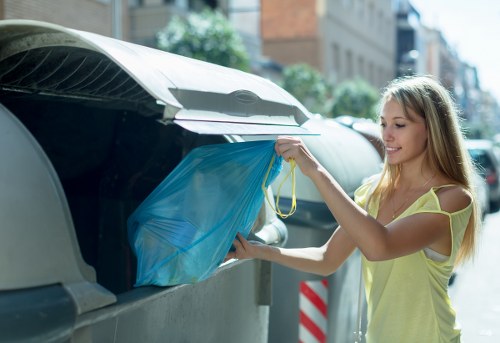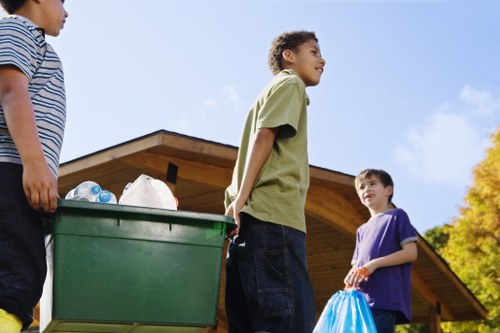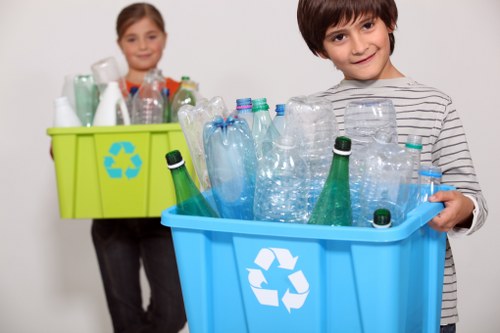Waste Removal Woodlands: Keeping Our Forests Clean and Sustainable

Waste removal in woodlands is a crucial aspect of maintaining healthy forest ecosystems. Proper waste management helps preserve the natural beauty of these areas, protects wildlife, and ensures that woodlands remain sustainable for future generations. Whether it's residential waste, commercial debris, or natural litter, effective waste removal strategies are essential.
Woodlands provide numerous benefits, including clean air, habitat for wildlife, and recreational spaces for people. However, these benefits can be compromised if waste is not managed properly. Litter, plastic waste, and other pollutants can harm animals, degrade the environment, and make these areas less enjoyable for visitors.
Implementing efficient waste removal systems in woodlands involves several steps. It starts with educating the public about the importance of keeping these areas clean. Additionally, providing adequate waste disposal facilities and regular maintenance can significantly reduce the accumulation of waste.

Why Waste Removal in Woodlands Matters
Maintaining cleanliness in woodlands is not just about aesthetics; it’s about preserving the ecosystem. Waste left behind can disrupt natural processes, harm wildlife, and lead to the spread of invasive species. For example, plastic waste can take years to decompose, breaking down into smaller pieces that are ingested by animals, causing harm and even death.
Moreover, waste accumulation can alter the landscape, affecting soil quality and water sources. Organic waste, while seemingly benign, can attract pests and disrupt the natural decomposition process, leading to an imbalance in the ecosystem.
Effective waste removal also contributes to climate change mitigation. Decomposing waste in woodlands can release greenhouse gases, contributing to global warming. By managing waste properly, we can reduce these emissions and help combat climate change.

Challenges in Waste Removal
One of the main challenges in waste removal in woodlands is accessibility. Many woodland areas are remote and difficult to reach, making regular waste collection a logistical challenge. Additionally, seasonal variations, such as increased tourism during certain times of the year, can lead to higher volumes of waste that are difficult to manage.
Another challenge is public compliance. Despite awareness campaigns, not everyone adheres to waste disposal guidelines. This non-compliance can result in littering and improper disposal, exacerbating the waste problem.
Funding and resources also play a significant role. Effective waste removal requires investment in infrastructure, such as trash bins and collection vehicles, as well as personnel to maintain these systems. Securing adequate funding can be a hurdle for many woodland management authorities.

Strategies for Effective Waste Removal
To tackle waste removal effectively, a multifaceted approach is necessary. Here are some strategies that can be implemented:
- Public Education: Raising awareness about the importance of keeping woodlands clean can encourage more responsible behavior among visitors.
- Provision of Facilities: Installing sufficient waste bins and recycling stations in woodland areas can make it easier for people to dispose of their waste properly.
- Regular Maintenance: Scheduling regular waste collection and disposal ensures that waste does not accumulate and create bigger problems.
- Volunteer Programs: Engaging the community through volunteer clean-up initiatives can significantly enhance waste removal efforts.
- Use of Technology: Utilizing advanced technology for waste tracking and management can streamline the process and improve efficiency.

Innovative Solutions in Waste Management
Innovative solutions are being developed to enhance waste removal in woodlands. One such solution is the use of solar-powered waste collection vehicles, which reduce the carbon footprint associated with waste management. Additionally, smart bins equipped with sensors can notify authorities when they are full, ensuring timely collection.
Another promising innovation is the implementation of composting systems for organic waste. This not only reduces the volume of waste but also returns valuable nutrients to the soil, promoting healthy plant growth.
Advanced recycling techniques are also being explored to handle different types of waste more effectively. By separating and processing waste at the source, these techniques can minimize the environmental impact and promote sustainability.
Local Areas Near Woodlands and Their Waste Removal Efforts
Woodlands do not exist in isolation. Surrounding areas also play a vital role in waste management. Here are some nearby areas close to Woodlands that contribute to effective waste removal:
- Greenfield: Located just 5 miles from Woodlands, Greenfield has implemented a comprehensive recycling program that includes regular community clean-ups.
- Lakeside: Only 7 miles away, Lakeside focuses on managing water-based waste to protect its nearby lake from pollution.
- Pinecrest: At a distance of 10 miles, Pinecrest utilizes eco-friendly waste collection trucks to minimize environmental impact.
- Maple Grove: 12 miles from Woodlands, Maple Grove has established several composting sites to handle organic waste effectively.
- Oakwood: Located 8 miles away, Oakwood runs awareness campaigns to educate visitors about proper waste disposal.
- Birch Park: 6 miles from Woodlands, Birch Park collaborates with local businesses to reduce commercial waste.
- Cedar Valley: At 9 miles distance, Cedar Valley employs smart waste bins that alert authorities when they are full.
- Elm Street: 11 miles from Woodlands, Elm Street focuses on plastic waste reduction through innovative recycling methods.
- Willow Bend: Located 4 miles away, Willow Bend engages the community through volunteer clean-up events.
- Spruce Hill: 3 miles from Woodlands, Spruce Hill uses solar-powered vehicles for waste collection, promoting sustainability.
The Role of Technology in Waste Removal
Technology plays a significant role in enhancing waste removal processes in woodlands. The integration of smart systems allows for better monitoring and management of waste. For instance, RFID tags on waste bins can track usage patterns, helping authorities allocate resources more efficiently.
Mobile applications can also facilitate waste reporting, enabling visitors to report overflowing bins or illegal dumping in real-time. This immediate feedback can help address issues promptly and maintain cleanliness.
Moreover, data analytics can provide insights into waste generation trends, allowing for more effective planning and implementation of waste management strategies. By leveraging technology, waste removal in woodlands can become more efficient and responsive to the needs of both the environment and the community.
Community Involvement and Volunteerism
Community involvement is essential for the success of waste removal initiatives. Volunteers can significantly contribute by participating in clean-up events, educating others, and advocating for sustainable practices. Engaging the community fosters a sense of ownership and responsibility towards maintaining the cleanliness of woodlands.
Schools, local organizations, and businesses can collaborate to sponsor or organize volunteer programs. These initiatives not only help in waste removal but also promote environmental awareness and stewardship among participants.
Incentive programs, such as recognition awards or community events, can motivate more people to get involved. When the community works together, the impact of waste removal efforts becomes more substantial and sustainable.
Policy and Regulation
Effective waste removal in woodlands also depends on supportive policies and regulations. Governments and local authorities need to establish guidelines that mandate proper waste disposal and penalize littering. Policies should also encourage the use of eco-friendly materials and promote recycling and composting.
Grant programs and funding opportunities can support waste removal projects, providing the necessary resources for implementation. Additionally, collaboration between different government agencies can ensure a coordinated approach to waste management.
Regulations should also focus on reducing waste generation at the source. By promoting practices such as reducing, reusing, and recycling, policies can help minimize the amount of waste that ends up in woodlands.
Future of Waste Removal in Woodlands
The future of waste removal in woodlands looks promising with ongoing advancements in technology and increasing awareness about environmental conservation. Innovations such as autonomous waste collection vehicles and advanced recycling technologies hold the potential to revolutionize waste management in these areas.
Sustainable practices, including zero-waste initiatives and circular economy models, are gaining traction and can significantly reduce the environmental impact of waste. These practices focus on designing products and systems that minimize waste generation and maximize resource efficiency.
Moreover, continuous community engagement and education will play a crucial role in ensuring the long-term success of waste removal efforts. By fostering a culture of sustainability and responsibility, we can ensure that woodlands remain clean and vibrant for generations to come.
Conclusion
Waste removal in woodlands is vital for preserving these natural treasures and maintaining their ecological balance. Through a combination of effective strategies, community involvement, technological advancements, and supportive policies, we can address the challenges of waste management and ensure that woodlands remain clean and sustainable.
Protecting our woodlands requires a collective effort from individuals, communities, and authorities. By prioritizing waste removal and adopting sustainable practices, we can safeguard the environment, support biodiversity, and create enjoyable spaces for everyone.
Let’s commit to keeping our woodlands clean and thriving, ensuring that these beautiful landscapes continue to benefit both nature and people for years to come.
Frequently Asked Questions
1. Why is waste removal important in woodlands?
Waste removal is essential in woodlands to protect wildlife, maintain the ecosystem, prevent pollution, and ensure that these natural areas remain clean and sustainable for future generations.
2. What are some effective strategies for waste removal in woodlands?
Effective strategies include public education, provision of waste disposal facilities, regular maintenance, volunteer programs, and the use of technology to monitor and manage waste efficiently.
3. How can the community get involved in waste removal efforts?
The community can participate in clean-up events, volunteer for waste management projects, educate others about proper waste disposal, and support local initiatives aimed at keeping woodlands clean.
4. What role does technology play in waste removal?
Technology enhances waste removal by providing smart waste bins, tracking waste generation, facilitating reporting of waste issues, and enabling efficient resource allocation through data analytics.
5. How do local policies and regulations impact waste removal in woodlands?
Local policies and regulations set guidelines for proper waste disposal, enforce penalties for littering, encourage recycling and composting, and provide funding and support for waste removal initiatives.